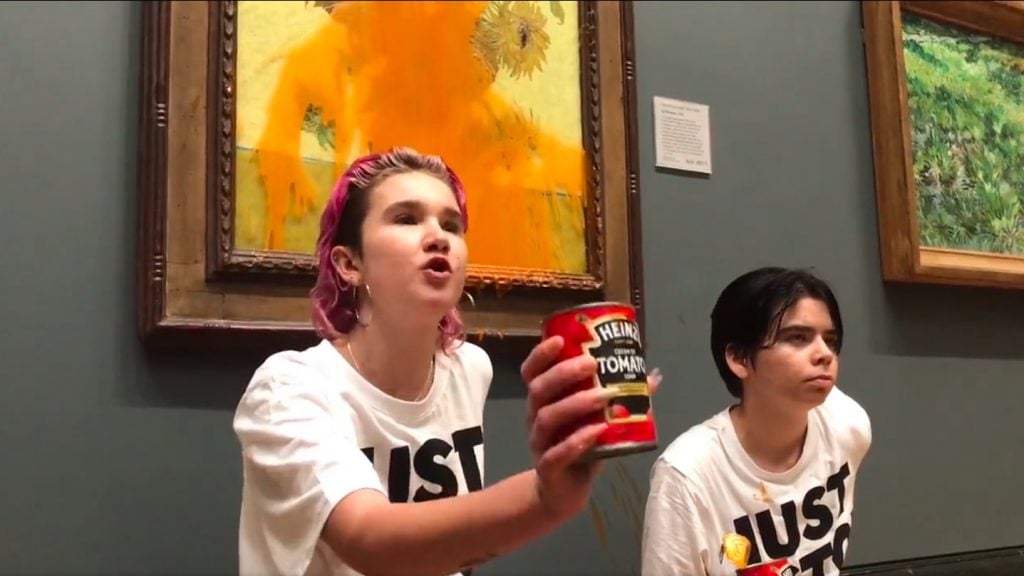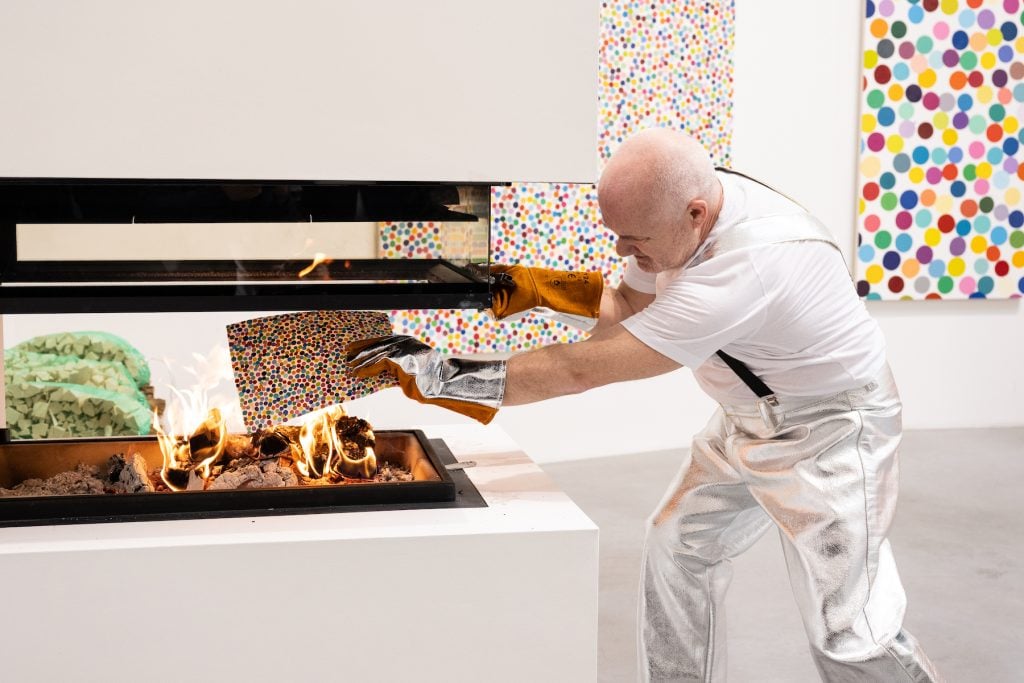The Gray Market
What the Rising Tide of Art Vandalism Tells Us About Where We Are Headed as a Culture
Our columnist connects the targeting of artworks in museums, on television, and in the art market to the troubling trajectory of culture at large.

Our columnist connects the targeting of artworks in museums, on television, and in the art market to the troubling trajectory of culture at large.

by
Tim Schneider

Every Wednesday morning, Artnet News brings you The Gray Market. The column decodes important stories from the previous week—and offers unparalleled insight into the inner workings of the art industry in the process.
This week, getting aggressive…
Climate activists throwing food at (or gluing body parts to) canonical artworks in European museums, a British TV show buying problematic artworks so a studio audience could decide if they should be destroyed live on air, and a blue-chip artist and multiple fly-by-night crypto firms (separately) coaxing the public to pledge allegiance to NFTs by burning the tangible artworks they originated from. While there are important differences between each of these episodes from the past 20 months, they all raise the same question: Why have so many people decided to make so many different points by physically targeting works of art?
I don’t think the answer is all that complicated, but it increasingly feels as if the art industry isn’t talking nearly enough about what it means—or what is likely to happen next.
Let’s work backwards from climate activism. To recap, in mid-October, two members from the group Just Stop Oil chucked tomato soup at a Van Gogh Sunflowers painting in London’s National Gallery. Roughly a week later, another pair from a likeminded organization in Germany, Letzte Generation (Last Generation), flung mashed potatoes at a Monet in mega-collector Hasso Plattner’s Museum Barberini in Potsdam. A week after that, a security guard in Paris prevented another Just Stop Oil protester from souping another Van Gogh at the Musée d’Orsay… while, a few hundred miles away, an activist superglued (or rather tried to superglue) his head to Vermeer’s The Girl With a Pearl Earring at the Mauritshuis in The Hague.
The episodes above were an escalation of a gentler wave of direct actions that took place earlier this year. In those cases, as my colleague Sarah Cascone pointed out, activists from the same or similar groups glued or chained themselves to the frames, plinths, or railings of major artworks instead of the actual art pieces. The rationale for this principled avoidance? “It’s important for us to value art, instead of damaging it, like our governments do with the only planet,” the Italian faction Ultima Generazione said in a statement, relayed by German news outlet DW, after a string of such actions in Italian cultural institutions.
I should emphasize that all the works targeted in the past month by Just Stop Oil and Letzte Generation were behind glass, meaning that not a single piece was damaged in the protests. Still, it seems the groups in question felt the need to take a harder line once cooler temperature arrived. Enter foodstuffs and adhesive skin contact.
The tactical shift has certainly amplified the organizations’ presence in the art-world and mainstream-media discourse. Whether it has delivered the right message, however, is another matter. Aside from a few pockets of support from other climate activists and the wider world, most of the public’s reaction has stratified to two positions. The first is that the protesters are a threat to both the artworks and the ecological causes they’re hoping to advance. The average bystander is likely to view these demonstrations as disruptions of the peace that align green-energy policies with juvenile delinquency, not justice—an idea supported by the insults thrown at them by museum goers in videos taken of the actions mentioned above.
i will avenge u mr van gogh pic.twitter.com/FnB6Q2RHyY
— im not reading all that (@LilNasX) October 25, 2022
The second position, however, is that the protesters are just ridiculous rapscallions doing ridiculous things, and that their main purpose is to feed the meme cycle. Approximately 10 days after the Just Stop Oil stunt at the National Gallery, U.S. pop star Lil Nas X went viral on social media with a post featuring a Photoshopped image of him throwing a Sunflowers painting at one of Warhol’s Campbell’s Soup Cans with a caption that read: “i will avenge u mr van gogh.” This Monday, two comics posted a video in which they tried to sell canned soup to visitors who might have wanted to make their own climate statements at the Met and Guggenheim.
It goes without saying that neither of these posts actually advocates slinging foodstuffs at works of art in museum collections. They’re just having fun with a little jet stream in the zeitgeist. What’s the harm in that?
But here’s the thing: as memes migrate through online culture, they tend to migrate in tone, too. Outlandish ideas get normalized through social-media humor, general clout-chasing, and more pointed agendas; then a few people feel justified in going offline to take the increasingly normalized ideas even further. By now we’ve seen this progression happen in everything from the advisable uses of laundry detergent and the organic (un)reality of birds to the believability of urban legends, the adoption of bogus COVID-19 treatments, and of course, our increasingly militarized politics.
The internet didn’t create this problem. As my colleague Ben Davis wrote in his book Art in the After-Culture, the concept of the Illuminati—arguably the cornerstone of modern conspiracy theorizing—“began in the 1960s as a satirical religion, Discordianism, propagated by artist pranksters as a satire of conspiracy theories, with the quixotic hope that attributing every historical event to a single cabal would inspire skepticism about such sweeping claims.” But once this well-meaning puppy was let off its leash, a world that didn’t get the joke (or didn’t care to) turned it into a rabid dog. The internet and social media have only made it possible for that transformation to occur faster than ever.
To be clear, I’m not equating the current state of the “physical attacks on artworks” discourse to the malign state of the Illuminati discourse, let alone its often-dire consequences. I’m just saying that once a previously niche or taboo subject starts propagating through the wider culture, it’s important to think seriously about how far it could go and how much it could change along the way to its destination, especially once it starts mutating. And those mutations are definitely underway when it comes to vandalizing or vanquishing artworks.

Jimmy Carr presented Jimmy Carr Destroys Art on the U.K.’s Channel 4. Photo courtesy of Channel 4.
For the uninitiated, Jimmy Carr Destroys Art is a show that premiered on the U.K.’s Channel 4 only two days after Last Generation protesters whipped mashed potatoes at Hasso Plattner’s Monet. The concept is as simple as it is scandalous: the host moderates a debate between various guests about whether or not the world would be better off if certain cringey works by controversial artists were obliterated forever. Then the studio audience votes whether or not to make that threat a reality. The lineup includes pieces by Adolf Hitler, convicted pedophile Rolf Harris, and documented misogynist Pablo Picasso, among others, all of which were purchased by the network for this Roman Colosseum style referendum.
The show, the producers, and the host have all been walloped in the court of public opinion since Jimmy Carr Destroys Art was announced, as well as after the episode aired. Some observers pilloried Channel 4 for assigning Carr, who joked about the Holocaust in a recent Netflix special, to host a show that featured a Hitler painting. Others decried the entire premise, wondering how the network could even green light the project in the first place, let alone go through with shooting and broadcasting it.
Well, it probably hasn’t helped that at least a few in the art trade itself have been orchestrating publicity stunts that normalize the validity of demolishing artworks. In March 2021, a DeFi startup called Injective Protocol purchased a 2006 Banksy drawing for $95,000, minted the work (titled Morons [White]) as an NFT, and then live-streamed the torching of the physical work in a ploy to boost the value of the corresponding digital asset. It paid off; the NFT went on to sell for $380,000. The next month, a separate crypto venture, Daystrom, minted an NFT of a 1986 Jean-Michel Basquiat drawing it had acquired, pledged to auction the NFT on the OpenSea trading platform, and granted the winning bidder the right to destroy the tangible piece—until the Basquiat estate defused the caper by threatening legal action. This fall, a shifty entrepreneur incinerated a purported Frida Kahlo sketch in a bizarre online spectacle to promote his series of 10,000 Frida-related NFTs.
(Oh, and if you want to tab Banksy and his remote-control shredder as an early node in the growing art-destruction network, I would understand. I just feel like anything that happened four years in the past exceeds the statute of limitations on this trend.)
Cue Damien Hirst. In July 2021, the British provocateur and blue-chipper launched “The Currency,” a series of 10,000 NFTs minted from, and sold with, 10,000 corresponding works on paper. The conceptual hook? Whoever owned the works a year later would get to decide whether to keep their drawing and digitally “burn” the associated crypto token, or keep the crypto token and physically burn the associated drawing. Although he eventually undermined the premise by gifting the holders of “Currency” NFTs new drawings, Hirst followed through on incinerating the tangible works abandoned for love of the blockchain during an event staged to coincide with this year’s edition of Frieze London. It was, to put it mildly, a whole scene, with supporters cheering on the artist as he fed paper to the flames in his Newport Street Gallery.
The event was as on-brand as it gets for the self-styled bad boy. The problem is that I don’t think its effects ended when the literal fire went out.

Damien Hirst takes part in the burning of his artworks at Newport Street Gallery on October 11, 2022 in London, England. (Photo by Jeff Spicer/Getty Images)
Describing the circumstances around these physical attacks on art proves that each has its own set of motivations and goals. Climate activists are trying to force righteous policy changes by using nonviolent spectacle to remind the broader public that cultural treasures won’t matter if lawmakers continue to allow the world to keep sliding into an ecological hell. Channel 4 and Jimmy Carr are, in my eyes, hammering the vital, nuanced task of re-evaluating the relationship between artists’ lives and works into lowest-common-denominator shock jockeying for ratings. The aforementioned crypto firms and Hirst operationalized the reductive premise that a digital asset can only reach its full value if it is freed from the ballast of a physical source—an idea born out of some combination of ingrained destructive impulse and borderline brain-death that, as far as I can tell, seems to disproportionately afflict men—to drive pump-and-dump schemes during the great crypto runup of 2021.
The distinctions matter until, suddenly, they don’t. Once an idea leeches into the bloodstream, there’s no telling how far or how fast it will spread. And I fear this thing is metastasizing in ways we are not yet appreciating.
This is especially true because the body politic didn’t have all that many immunities to it in the first place. The harsh truth is that we art lovers, let alone art professionals, make up an extreme minority of the larger population. Self-described fans of “culture” increasingly define the concept as a flattened mélange of everything from food trucks and Instagram traps to the Louvre and the Met Opera. That’s fine. The problem is that extreme privilege and wealth seem to be the strongest association many, if not most, of the rest of the country has with the specific type of art that aspires to museums (and really, who can blame them?). Worse, the public often understands that this extreme privilege has come from doing direct harm, whether the harm is actually proven or just perceived.
A lot of people in the post-pandemic world are looking for ways to send message to old-guard elites (or at least to pander to populists). As much as we like to think that making art can be a way to speak truth to power, so can damaging it. Nor is this connection new. Remember, the term “vandalism” was coined to describe the destruction of fine art by the aggrieved masses during the French Revolution.
For now, splashing food onto paintings is a strictly European phenomenon. Jimmy Carr Destroys Art could max out as a weird footnote in the history of British television. Self-important artists and hype beasts have been trying to profit from attacking their own art (and the art of others) for centuries without the trend morphing into a melee.
Still, it feels to me like something has curdled since the pandemic. This would be a bad situation for visual art on its own, but it’s even worse when it’s part of the most heated culture wars we’ve seen in decades. To cite just one related example, Pen America confirmed that more than 2,500 new book bans were implemented in the U.S. during the 2021-22 school year alone. Censorship efforts also extend for “the first time [to] educational gag orders,” defined as “state legislative efforts to restrict teaching about topics such as race, gender, American history, and LGBTQ+ identities in K–12 and higher education.” If you think paintings and other artworks don’t have much to fear while dozens of advocacy groups try to wipe out entire strains of learning in what is the world’s largest art market, I guess the most diplomatic thing I can say is that I admire your optimism.
Personally, though, I feel like this mayhem is more likely to infiltrate into other regions and sectors of the art trade than it is to slink away. I’m a little surprised in retrospect that no one tried to hurl any groceries during the public viewings of the much-hyped Paul Allen collection ahead of the Christie’s auction. There have been rumors of disruptive climate actions being staged at Art Basel in Miami Beach since before the pandemic. Could this be the year when someone finally acts? (It’s not as if past visitors haven’t managed to make mischief—or do much worse—for less principled reasons during past editions of the show.)
Even if security guards manage to sniff out every thermos of soup and tube of superglue that climate activists try to smuggle into museums, how will U.S. art institutions be able to keep collections safe now that 25 of the 50 states are on track to empower citizens to carry guns without a permit and/or a requirement to keep them visible? And since I know what some of you are thinking, what happens if it’s decided that the entrance to every major art experience has to become a TSA checkpoint to maintain order? My answer is “nothing good.”
Believe me, I understand the urge to just roll your eyes and move on from soup-chucking climate protesters, try-hard TV gimmicks, and Damien Hirst in general. I just think that we dismiss the connecting thread between these episodes at our own peril. Most of us got into this punishing business because we believed in art’s capacity to make a point to the wider world. But we also have to recognize that the relationship can work both ways, whether we like it or not.
That’s all for this week. ‘Til next time, remember: sometimes food for thought can be taken way too literally.